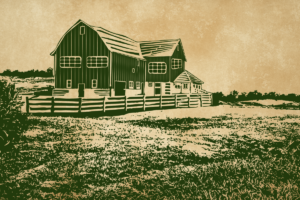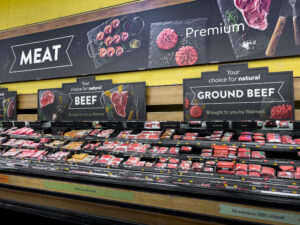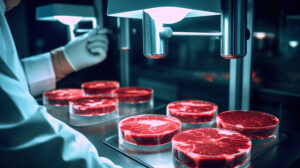How Industrial Agriculture Took Over Our Food System
Government-backed factory farming has become a dominant force in the last five decades. Image: Adobe
Image: Adobe
It’s evident that wars and extreme weather from climate change have disrupted farming — affecting animals, food and prices globally. In response, government-backed intensive agriculture, also known as factory farming, has become a dominant force in the last five decades. It’s a powerful system that produces plentiful and affordable food worldwide…while benefiting large corporations.
Now, as we look ahead to the future of food, we expect industrial farming to keep playing a huge role. That’s where a sustainable intensification approach comes in — it’s all about making more food using less land and water. But globally, intensive farming has a long way to go to be truly sustainable. Here’s what you need to know about what intensive agriculture is, how it harms all of us — and potential alternatives.
What Is Industrial Agriculture and How Does It Work?
Intensive agriculture — often called industrial agriculture — is a farming method focused on producing maximum plant and animal yields within limited land areas. It earns its “intensive” label by employing advanced technology, machinery, seeds and animals, and by using inputs such as water, chemical fertilizers, herbicides and pesticides in concentrated zones.
Industrial agriculture also relies on practices such as monoculture farming, extensive plowing, heavy chemical usage, abundant irrigation and mechanization, thereby reducing the need for human labor. When it comes to meat and dairy production however, intensive agriculture is often at odds with animal welfare. Livestock are often crowded, confined, hormonally accelerated and artificially bred in ways that raise output — and ethical concerns.
This style of farming also often depends on uniform and single-crop resources — such as genetically modified corn and soy, and animals bred for maximum profit. The results are low-cost feed crops, meat and dairy products, usually distributed through vast supply chains to national and global markets. There, the massive commodity crops like soy and corn are used in animal feed, biofuels and processed food.
Features of Intensive Agriculture
There are many different features of intensive agriculture. They vary according to whether farmers are producing crops or raising animals.
Concentrated Animal Feeding Operations (CAFOs)
Concentrated animal feeding operations (CAFOs) describe the component of industrial agriculture that involves farmed animals. These tend to be large-scale facilities that hold many individuals in confinement for at least 45 days a year. The U.S. Environmental Protection Agency defines CAFOs on the basis of how many animals they house, and the pollutants they produce. A “big CAFO” usually houses a minimum of 1,000 beef cattle, 700 dairy cows, 2,500 large pigs or 82,000 egg-laying hens. The population of animals in CAFOs throughout the United States has consistently increased over the last many decades. In 1970, the typical dairy farm had only 19 cows, but by 2006, that number had risen to 120. Presently, the largest farms house over 15,000 cattle.
Corporate Consolidation
Corporate consolidation — that is, the increasing concentration of power and control within a few large corporations — has become increasingly common in intensive agriculture. Big companies buy smaller ones, which leads to a smaller number of dominant players in the market. Mergers and acquisitions play a vital role here in driving this consolidation. As a result, a handful of multinational corporations lead across the supply chain, from seed production to food distribution. Nowadays, the four biggest companies in each industry process 73 percent of beef, 67 percent of pork and 54 percent of chicken.
Deforestation
Intensive agriculture plays a significant role in global deforestation — most famously in regions like the Amazon rainforest. In the Amazon, practices like burning and clear-cutting destroyed nearly a million square kilometers of forest. These actions serve various purposes, primarily to expand animal grazing and monoculture farming for feed crops. Yet deforestation has far-reaching consequences for the planet, as it destroys natural climate solutions like forests, which storing carbon rather than releasing it into the atmosphere. Alarmingly, the rate of deforestation is on the rise.
Intensive grazing by farm animals such as cows and sheep can also degrade pasturelands and their soils. That’s where pasture intensification comes into play, which alters grasslands by sowing specific grasses or legumes. There are also other practices that increase the productivity of grazing land, such as the application of fertilizers.
Crop Irrigation
As with pastureland, farmers irrigate crops to encourage plant growth. Farmland irrigation accounts for around 70 percent of total freshwater consumption by people. The practice can have negative impacts, such as contaminating water sources nearby. It can also affect the weather in distant locations, as it boosts water evaporation from land. In 2016, researchers used simulations to show that irrigation in Asia could impact rainfall in Africa.
Rotational Grazing
Rotational grazing is a method of farming that incorporates pastured animals into its production system, primarily using these animals for fertilizer. Under this system, farmers can allow different areas of the farm to “rest” from grazing, enabling vegetation there to grow. While there is evidence that rotational grazing can benefit soils, these systems also reduce biodiversity and require much more land than conventional systems to produce the same amount of food.
Use of Agrochemicals
Agrochemical use is a staple of intensive farming. These products include fertilizers that typically contain nutrients like nitrogen and phosphorus to encourage plant growth. Farmers rely on a mix of synthetic and natural pesticides to kill organisms, such as insects and rodents, that damage crops and hinder yields.
Drain on Land and Water
Industrial agriculture consumes substantial water resources; at least 20-33 percent of all freshwater consumption in the world goes to animal agriculture alone. Meat and dairy production takes up 83 percent of farmland, but provides only 18 percent of our food calories. In the United States, 127 million acres grow animal feed.
Genetically Modified Organism (GMO) Seeds
Intensive agriculture relies on the use of genetically modified organism (GMO) seeds, primarily corn and soy. The term GMOs historically referred to a process called transgenesis — the precise engineering of organisms through the introduction of genes. This includes introducing genes from entirely different species to produce a desired outcome, such as resistance to disease or faster growth. Today, gene-editing tools including CRISPR, which is a technique used to improve crops without adding new genes.
One method of creating GMOs begins with scientists first identifying a useful gene. Then, they insert this gene into the target plant. Another advanced approach uses agrobacterium, which naturally invades plant cells and inserts genetic sequences. Researchers have adapted this method to introduce other genes, such as those for drought resistance. “Marker genes” help confirm the plant has accepted the new DNA.
Hormones
In intensive agriculture, cows and sheep often receive steroid hormones. These hormones include estrogen, testosterone and progesterone that boost their growth and muscle development. This is usually delivered through small implants placed under the animals’ skin, gradually releasing steroids over time. To increase milk production, farmers give a specific hormone to dairy cows, bovine somatotropin (bovine growth hormone).
Farmers also often give antibiotics to animals as a preventative measure, due to the unclean conditions in which they are kept. This poses a risk of antibiotic resistance for the humans who later consume them — not because the animals contain antibiotics but resistant residue, which is also spread through soil and water. Blood farms, where pregnant mares are used to extract hormones to boost pig production, are also on the rise.
Agrichemicals and Biodiversity
Industrial agriculture relies on various chemicals to deter pests and enhance crop yields, including pesticides, herbicides, fungicides, acaricides (used to target mites), fertilizers and soil conditioners. However, the practice of monocropping can also increase the vulnerability of crops to pests and diseases due to the lack of biodiversity, as well as an over-reliance on these chemicals. Fields dominated by a single crop — without any natural reserves set aside — are easier targets for specific insect pests, compared to fields with a variety of crops. Sadly, 75 percent of the world’s crop varieties have been lost since the 1920s as the world’s food systems shifted towards monoculture and industrial intensification.
Without Intensive Agriculture, Can We Still Feed the World?
Intensive agriculture has significant adverse effects on the environment — climate change, loss of biodiversity, animal welfare concerns and threats to human health. Despite these challenges, it’s often presented as the sole solution to address global hunger and food insecurity.
The good news is that it’s entirely possible to feed two billion more people by 2050, but it’s impossible to achieve this goal without populations in the global north eating a lot less meat. To make these shifts successfully necessitates fundamental changes in economic, political, cultural and infrastructural systems.
What Types of Intensive Agriculture Exist?
How intensive agriculture works in practice depends on the production system.
Livestock
Official estimates show that the U.S. slaughtered 165 million animals — excluding chickens and fish — in 2020. Of these animals, 99 percent are contained in factory farms. The number of farmed animals living on factory farms globally is 90 percent. According to Faunalytics, humans kill around 70 billion land animals annually for food.
In intensive operations, natural animal behavior is sometimes treated as an impediment to productivity. Neglect and abuse are common, as undercover investigations have exposed multiple cases of violence against animals in such facilities.
Aquaculture
Aquaculture is the intensive farming of fish, rather than catching them in the wild. These farms can be tanks on land, or contained areas of fresh water or ocean waters. Fish farming contributes to the depletion of wild fish communities, since such farms generally rely on wild fisheries to feed their farmed fish, and is also driving antibiotic resistance as facilities often use massive amounts of medicines to prevent disease spread in crowded tanks and pens.
Crops
Large-scale farm operations are typical of intensive crop production, which is designed to maximize growth of high-yielding crops. Farmers primarily grow these plants for livestock feed and energy use, rather than food for people.
Massive swaths of U.S. crop production go to feed farm animals. The U.S. Department of Agriculture states that farmers grow most of the 90 million acres of corn just for livestock feed and fuel ethanol production. The nonprofit Greenpeace found that 62 percent of European cereal crops went to animal feed between 2018 and 2019.
Intensive Versus Extensive Agriculture
Intensive agriculture prioritizes high yields whereas extensive agriculture relies on what its advocates believe are more “natural” practices. Both systems are responsible for expanding farmland operations into forests and wild habitats, and increasing the risk of zoonotic disease outbreak.
Why Is Intensive Agriculture Bad for the Planet?
Above all, intensive farming’s ability to drive profitability is what’s led to its meteoric rise. This profit has, however, come at a big cost for people, animals and the planet.
How Does Intensive Agriculture Cause Water Pollution?
Intensive animal farming systems are notorious for polluting water systems, thanks to excess nitrogen and phosphorous leaching from the misapplication and poor storage of manure and fertilizer. Alongside sewage systems, animal manure from these farming operations is a leading cause of water pollution.
How Intensive Farming Contributes to Climate Change
Meat and dairy companies are mainly responsible for the vast greenhouse gas emissions associated with agriculture, including methane. Beef, and by some calculations lamb, has the largest carbon footprint among food. These ruminant animals have the ability to digest all sorts of hardy pasture and crop leftovers in their multi-chambered stomachs — but the downside is these animals belch a toxic greenhouse gas called methane as they digest. Coupled with the large amount of land used to graze, beef and lamb are some of the most damaging foods you can eat, at least in terms of climate impact. Some meats like chicken and pork require fewer emissions but are also far worse in terms of animal welfare. The bottom line: all meat and dairy products have higher carbon footprints than plant-based foods.
What Are the Alternatives to Industrial Agriculture?
The alternatives to industrial agriculture are organic farming, regenerative agriculture, permaculture and semi-intensive farming. These methods prioritize environmental health, biodiversity and long-term food security. These more sustainable methods of farming reduce chemical use, conserving soil health and fostering local food systems.
Organic farming has seen significant growth in recent years. The sales of organic food surged from a modest $15 billion in 2006 to an impressive $50 billion in 2018. Between 2011 and 2016, there was a substantial 56 percent rise in the number of certified organic farms.
Does Industrial Agriculture Affect Human Health?
Industrial agriculture also poses risks to human health. In factory farming, the administration of antibiotics and drugs to animals is routine, leading to the rise of so-called “superbugs” — bacteria resistant to antibiotics. The consumption of animal products, as well as the washing of manure used to fertilize crops into waterways, can expose humans to superbugs that inevitably render some drugs ineffective when we need them.
Antimicrobial-resistant bacteria are a major threat to human health, linked to some 700,000 deaths annually worldwide.
Producing Poor-Quality Food
The industrialized food system produces cheap food. The low prices are misleading, however, as there are costs to the environment that we don’t see at the supermarket. This is referred to as the “cheaper food paradigm,” whereby cheaper food is only made possible by discounting or “externalizing” the environmental cost, namely destruction and pollution, involved in its production.
The Scottish fish farming industry has, for example, faced numerous scandals related to poor-quality fish. An investigation of fish farms there conducted in 2020 by Compassion in World Farming revealed “salmon with deformities and disease, missing eyes, and sea lice eating away large chunks of flesh and skin.”
Human Disease Risks
Intensive farming, including CAFOs, create air and water pollution that results in increased risk of asthma for CAFO workers and children who live nearby. CAFO and slaughterhouse workers also experience high rates of injury, as well as alcohol and drug abuse. CAFOs can also result in an increased spread of pathogens and antibiotic-resistant bacteria.
Some pesticides are more toxic than others, and can cause an increased risk of disease to workers who have higher exposure to these chemicals than consumers. In addition, even phased out or banned pesticides often persist in soil for decades.
Pandemic Risk
Putting many animals close together in factory farms makes it easier for diseases to spread to humans, and eventually create a widespread pandemic. Quite often, these diseases mutate, and can sometimes become even more dangerous to both animals and people.
Soil Health
Intensive agriculture has also taken a huge toll on the health of soils. Agrochemical use, overgrazing and extensive tillage have led to widespread soil erosion, particularly of vital and fertile topsoil.
It’s worth noting that the production of cheap eats like high-sugar, high-fat foods can also contribute to health problems — including obesity and diet-related diseases.
Poorly managed applications of pesticides and fertilizers end up damaging or killing the very organisms that agriculture relies on for soil health. Meanwhile, mechanized tilling fractures and disturbs the structure of soil. The UN Environment Program has highlighted that overuse of chemical fertilizers can render nature’s own fertilization process “obsolete.”
The Bottom Line
Supporting sustainable intensification at a global level while also boosting local food sovereignty efforts is something policymakers can do to boost crop diversity and community agriculture projects alike. Advocating for increased regulation and oversight of intensive farm systems would also help curb intensive agriculture’s planetary and animal impacts.
Critically, people in countries which tend to over-consume animal products, which is most of the global north, can eat more plants and reduce their meat and dairy intake. This is a central element of the change needed to fix our food system and address the climate crisis.
Research for this story was supplied by Tracy Keeling.
Your support is crucial…With an uncertain future and a new administration casting doubt on press freedoms, the danger is clear: The truth is at risk.
Now is the time to give. Your tax-deductible support allows us to dig deeper, delivering fearless investigative reporting and analysis that exposes what’s really happening — without compromise.
Stand with our courageous journalists. Donate today to protect a free press, uphold democracy and unearth untold stories.









You need to be a supporter to comment.
There are currently no responses to this article.
Be the first to respond.